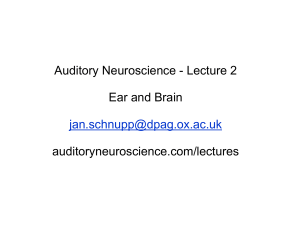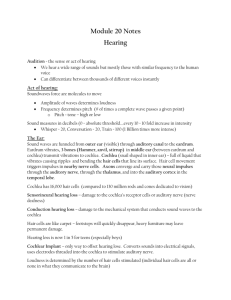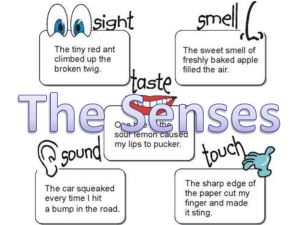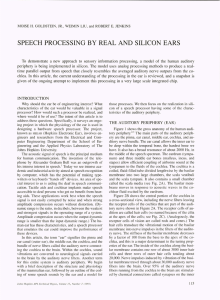Anatomy & Physiology Overview
advertisement
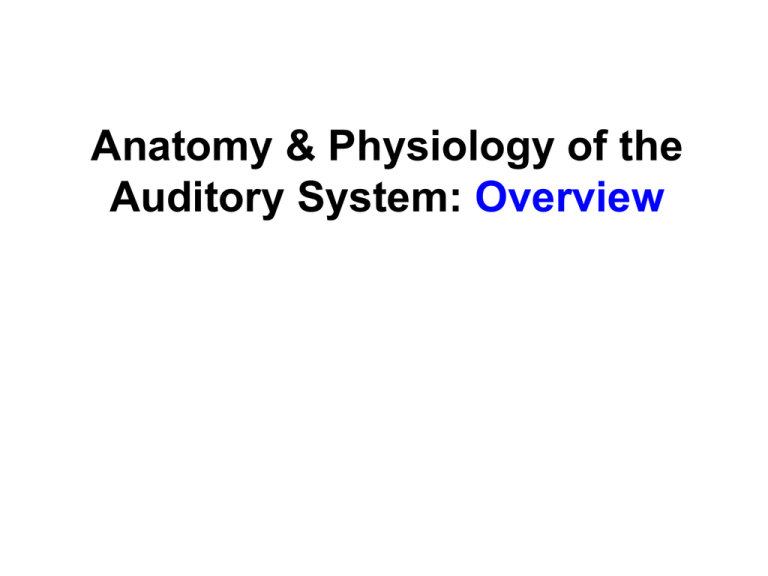
Anatomy & Physiology of the Auditory System: Overview Capabilities of the Auditory System What does the auditory system do and how well does it do it? Hearing Sensitivity The faintest sound that can be detected by the human ear is so weak that it moves the ear drum a distance that is equivalent to 1/10th the diameter of a hydrogen atom. If the ear were slightly more sensitive we would hear the random particle oscillations known as Brownian motion. We will see soon that the Motioninner ear transforms acoustic detecting cilia vibrations into neural impulses through the operation of motion-detecting receptor cells in the cochlear called hair cells. Hair cells get their name from the tiny hairs (cilia) that project up from the tops of these receptor cells. The movement of these cilia begins the process of hair cell converting acoustic vibrations into impulses on the 8th N. How much movement of the cilia is needed to barely detect a sound? From auditory physiologist Peter Dallos: If you scale the dimension of … one cilium to the height of Chicago's Sears Tower, the movement of the tip of the cilium at the threshold of hearing is equal to a two-inch displacement at the top of the tower. Dynamic Range The most intense sound that can be heard without causing pain is approximately 140 dB more intense than a barely detectable sound. This means that that the dynamic range of the ear – the ratio of the most intense sound that can be heard without pain to the intensity of a barely audible sound – is an astounding 100 trillion to 1. Frequency Range and Frequency Discrimination The frequency range of human hearing runs from approximately 20 Hz to 20,000 Hz, a range of 10 octaves. For signal levels approximating conversational speech, the ear can detect frequency differences that are on the order of 0.1%, or approximately 1 Hz for a 1,000 Hz test signal. We’ll soon see that the auditory system utilizes an elegant mechanism that delivers sounds of different frequencies to different physical locations along the cochlea (e.g., a sound of one frequency will produce the greatest neural activity at one physical location while a sound of a different frequency will activate a different location). f = 300 Hz f = 3,000 Hz The difference in frequency that a listener can barely detect corresponds to a difference in physical location along the cochlea of about 10 microns (1 micron = one millionth of a meter, or one thousandth of a millimeter). This distance, in turn, is approximately the width of a single auditory receptor cell. Intensity Discrimination Under good listening conditions, listeners can detect intensity differences as small as 0.6 dB. Sound Localization Listeners can locate the source of a sound based on differences in the time of arrival between the two ears that are as small as 10 μs (i.e., 10 μs = 10 microseconds = 10 millionths of a second). Amazing Organ, Small Package The anatomy that supports this processing is a miracle of miniaturization. If you’re impressed by the size of the latest IPod, consider this: (1) The middle ear cavity is roughly the volume of a sugar cube. (2) The cochlea is even smaller, at approximately 5 mm in height (~0.2 inch) and approximately 9 mm in diameter (~1/3rd inch) at its widest point. (3) The hair cells, which behave like teeny microphones, are 10 microns (1/1000 of a millimeter) in width. Anatomy & Physiology Overview Three major functional subsystems: Conductive, Sensorineural, Central A. Conductive: pinna, ear canal, ear drum (tympanic membrane), and middle ear (containing the middle ear bones or ossicles) Functions: (1) transmission – mechanical vibration picked up at the TM is transmitted to the fluid-filled cochlea by way of the ossicles. (2) overcoming an impedance mismatch – sound wave is generated in air, a low-impedance medium, and transmitted to the fluid-filled cochlea, a high impedance medium. Without two cool tricks exploited by the middle ear, a good deal of this sound energy would be lost. We’ll see how this works later. It’s cool and mostly pretty simple. B. Sensorineural: Cochlea (part of the inner ear) and auditory nerve (8th cranial N). Functions: (1) Transduction: Transducers convert energy of one form into energy of a different form (e.g., microphones, loudspeakers, light bulbs, photocells). Receptors in the cochlea (hair cells) convert mechanical energy (the energy of vibration) into neurochemical energy (nerve impulses). (2) Spectrum analysis: Breaking a complex sound into its individual frequency components (like a prism or a Fourier analyzer). (3) Transmission: The nerve impulses that are stimulated by the hair cell transducers are transmitted to the CNS via the auditory nerve. C. Central: Brain stem and auditory cortex. Functions: This one is a little on the tricky side. Your text book, like most texts, lists the primary functions of the central system as: recognition, integration, and interpretation. Some examples: speech recognition, talker recognition, recognition of familiar melodies This part is definitely true: You can’t do any of these things with just a conductive mechanism, a cochlea, and an 8th N. The brain stem and cortex are heavily involved in these high-level abilities. The central auditory system is also heavily involved in more basic auditory abilities as well. Some important examples: sound localization pitch perception (probably) spectrum analysis (maybe – this is very unsettled) Bottom line: Central auditory system is definitely involved in higher level auditory abilities (recognition, interpretation, integration …), but it is also involved in more primitive or basic functions such as sound localization, pitch perception, and maybe even spectrum analysis. Overview of Hearing: The Big Picture The Cochlea Unrolled The basilar membrane snipped out and viewed from above. From our discussion of springs and masses, what do we know about how stiffness affects natural vibrating frequency? Which end of the membrane would respond best to a high frequency sound? Which end of the membrane would respond best to a low frequency sound? So, high frequency sounds show up at the basal end of the cochlea, low frequency sounds show up at the apical end, and mid-frequency sounds show up at the appropriate place in the middle. What kind of pattern would you expect for a complex tone consisting of 8000 Hz mixed with 200 Hz? What we have here is a frequency analyzer – very much like a prism, but using a mechanical resonance trick instead of refraction. Basilar membrane traveling wave High Frequency Low Frequency Basilar membrane traveling wave for a 1,000 Hz sinusoid Basilar membrane traveling wave for a 3,000 Hz sinusoid Basilar membrane traveling wave for a 300 Hz sinusoid The transduction story in a nutshell So far all we have is mechanical vibration – the back & forth vibration that is picked up at the TM is transmitted through the middle ear bones and is transformed into up & down vibration of the basilar membrane; that is, motion is turned into motion. The brain can’t do a thing with it until this vibratory motion is converted into the only language that the brain understand – nerve impulses; the simple, all-or-none spikes that are produced by neurons. The conversion of vibratory motion into nerve impulses is an example of transduction. To get a quick idea of how this works, we need to take a closer look at the cochlea. Again With The Unrolled Cochlea We take a slice thru the cochlea, which is a little like a garden hose, then take a look to see what’s inside the tube. There’s a lot of stuff in there.
